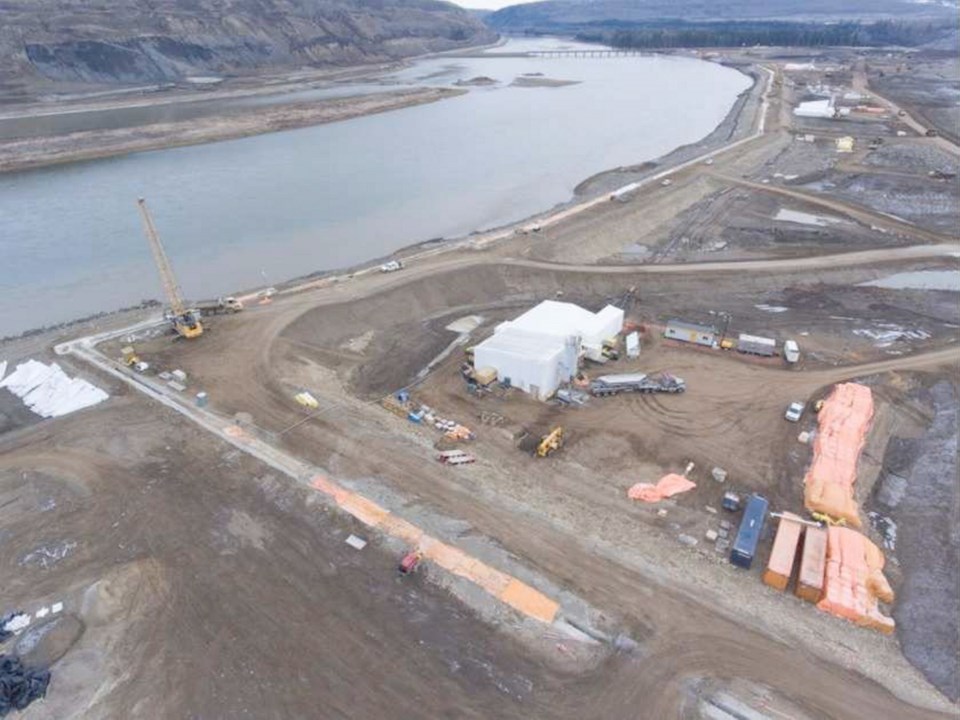The multi-billion-dollar Site C dam project on the Peace River is now officially in condition red, with significant cost overruns and delays due to the pandemic and a geological problem on the river bank.
B.C. Hydro filed a progress report with the B.C. Utilities Commission on Friday that rang several alarm bells about the power project, in contrast to previous filings that were generally more positive.
The government responded by appointing a former top Finance Ministry official — Peter Milburn — as a special adviser to review the project.
But it appears the only way through the problems is to carry on. Energy Minister Bruce Ralston stressed that the previous B.C. Liberal government had pushed the project “past the point of no return” three years ago.
There are now 24 million work-hours and more than $5 billion invested in the various huge excavation and construction projects on the Peace River. On cancellation, Ralston said: “I’m not sure that’s a realistic alternative.”
B.C. Hydro CEO Chris O’Riley told the utilities commission by letter: “We classified the overall health of the project as ‘red’, or having serious concerns, specifically regarding schedule, scope and budget.”
The mammoth project is being “re-baselined,” he said. That means a new budget, which has nowhere to go but up. O’Riley also said there is now uncertainty with the project schedule and the completion date of 2024.
The progress report was more definitive: “Milestones for first power and the in-service date will be affected.”
The estimated cost grew steadily over the decades the dam was planned and was listed as $10.7 billion after the NDP hit pause in 2017, then decided there was no choice but to proceed. That includes an $858-million contingency fund, which is already 76 per cent consumed. There’s also a Treasury Board reserve fund of $708 million, which B.C. Hydro plans to start drawing from this fall.
The most crucial immediate deadline involves the river diversion. It has to be routed through tunnels to allow for dam construction and it has to be done in the autumn.
O’Riley said diversion is still on schedule for this September. B.C. Hydro missed the first diversion deadline earlier and it added hundreds of millions to the budget.
When COVID-19 arrived in B.C., a substantial amount of the workforce was laid off, starting in March. Rehiring began in May, but the interruption has added cost pressures.
In March, $332 million was added to the $2.4-billion main civil works contract to provide more heavy equipment and incentive payments to ensure the schedule — including the diversion deadline — was maintained.
The project was already facing significant cost pressures prior to COVID-19. Earlier increases in the main contract, higher costs for related work and various First Nations legal actions were listed as reasons.
There’s also a big lurking expense to do with a problem on the river bank. Last December, long after construction had started, a need for additional foundation enhancements was identified to improve stability below the dam, powerhouse and spillways.
By March 31, it was determined the enhancements would have to be much more substantial than first thought. The builders are now evaluating several options, all of which involve more expensive work.
Cost overruns on major public works projects are a fact of life. This one will surprise no one, particularly when a pandemic strikes right in the middle of the biggest project in B.C.’s history.
But it’s still startling to see how rapidly Site C has run into serious problems. The routine progress reports only started listing cost pressures as a significant risk last winter.
Now there are four major indicators on the dashboard flashing red. The overall health of the project is in jeopardy. The overall scope is at risk because of the large amount of new foundational work that has to be done. The schedule is seriously at risk because of the work slowdown due to the virus. And the overall cost is at risk because of all of the above, on top of the cost pressures that were already in play.
Milburn is well-regarded, but there’s already lots of oversight on the project.
It’s going to take a lot more than a special adviser to work through this.



